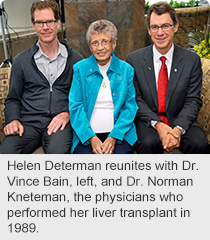
October 6, 2014
Story by Sharman Hnatiuk; photo by Mathew Martin
Helen Determan remembers why she was a little extra nervous before her liver transplant.
Her physicians – liver transplant surgeon Dr. Norman Kneteman and hepatologist Dr. Vince Bain. – looked young to her.
“Dr. Bain looked like a kid to me. He reminded me of my son,” recalls the St. Albert woman. “I was nervous to put my life in their hands but one of my nurses at the Royal Alexandra Hospital told me not to worry. She said, ‘They’ll take very good care of you.’ ”
 That, they did.
That, they did.
Her liver transplant took place in November 1989 when Dr. Kneteman was 34 and Dr. Bain 32.
A quarter-century later, Determan is still going strong. She’s a mother of four, grandmother of nine and a part of western Canadian medical history.
Determan, 70, is the third patient to receive a new liver through Western Canada’s first liver transplant program, founded by Dr. Kneteman and Dr. Bain in October 1989 at the University of Alberta Hospital (UAH).
The Liver Transplant Program at the University of Alberta Hospital has performed more than 1,400 transplants over the past 25 years, making the facility the second busiest site for liver transplants in Canada. The program has also driven improvements that have significantly improved patient outcomes and survival rates over the past quarter-century.
“Twenty-five years ago, we hoped a liver transplant would extend a patient’s life by 10 years,” says Dr. Kneteman. “Today, between 90 and 97 per cent of transplant patients survive the first year and many live healthy, active lives for another 20 years – and sometimes longer – thanks to advances in surgical techniques and anti-rejection medicines.”
Both doctors are still involved in the program. Dr. Kneteman is Clinical Section Chief for Transplant Services in the Edmonton Zone of Alberta Health Services; Dr. Bain the director of the University of Alberta Hospital Liver Unit.
More than 75 liver transplants were performed at the facility last year. Currently, the program has about 120 patients waiting for a liver transplant.
“I don’t think 25 years ago we ever would have predicted the volume of transplants today,” says Dr. Bain. “But liver disease has become much more prevalent and we are listing patients with diseases who would not have been suitable candidates 10 or 20 years ago. We have a huge opportunity to grow this program further but we are limited by the number of donor organs available. Although the number of transplants performed annually is increasing, the number of patients being referred for transplant has been rising, too. About one in three patients will die before a suitable liver becomes available.”
The first adult liver transplant in Edmonton was performed on Oct. 3, 1989; the recipient lived for 15 more years to the age of 69. The first pediatric liver transplant in Edmonton was performed in June 1990 and the patient is still alive. The Stollery Children’s Hospital remains Western Canada’s only pediatric liver transplant site.
The establishment of an Alberta liver transplant program came at a good time for Determan.
She was diagnosed with primary biliary cirrhosis, a disease where the bile ducts in the liver are slowly destroyed, leading to irreversible scarring of liver tissue. In 1989, she was told she had five years to live.
Determan waited two months for a suitable liver. Within days following her surgery, her yellow skin turned pink and, after six months of physiotherapy, she no longer needed a cane to walk.
“I still write a thank-you note and letter to the donor’s family each year,” says Determan.
Dr. Bain says more success stories like Determan’s are possible.
“The greatest risk is not in getting through the transplant surgery; it is waiting on the transplant list,” he says. “Waiting is far more dangerous. That’s the sad part. We have the technology and the expertise to save these patients, just an insufficient number of available organs.”
Albertans are encouraged to sign their organ and tissue donor card, located on the back of their Alberta Personal Health Card, register their intent to donate online through the Alberta Organ and Tissue Donation Registry at myhealth.alberta.ca , and most importantly, to discuss their wishes with their family.